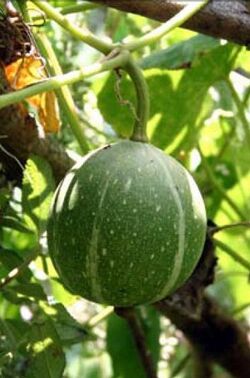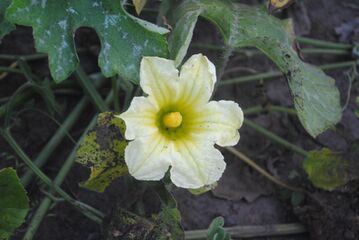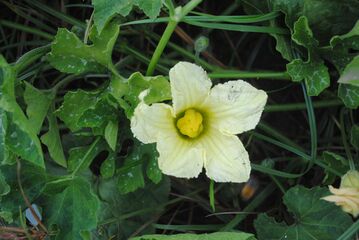Biology:Cucurbita okeechobeensis
| Okeechobee gourd | |
|---|---|

| |
| C. okeechobeensis subsp. okeechobeensis | |
| Scientific classification | |
| Kingdom: | Plantae |
| Clade: | Tracheophytes |
| Clade: | Angiosperms |
| Clade: | Eudicots |
| Clade: | Rosids |
| Order: | Cucurbitales |
| Family: | Cucurbitaceae |
| Genus: | Cucurbita |
| Species: | C. okeechobeensis
|
| Binomial name | |
| Cucurbita okeechobeensis | |
| Synonyms[2] | |
| |
Cucurbita okeechobeensis, the Okeechobee gourd, is a species of gourd in the family Cucurbitaceae, native to Mexico and the United States. There are two subspecies; one is endemic to Florida, primarily in the region around Lake Okeechobee, the other to the State of Veracruz in eastern Mexico.[3][4] Once abundant,[3] it has state and federal listing as an endangered species.[5] One of its peculiarities is the yellow corolla not so common in other Cucurbita species.
Description
A climbing vine, C. okeechobeensis leaves have irregular serrate margins with 5 to 7 angular, shallow lobes. Overall the leaf blades are heart or kidney-shaped. Young leaves are covered with downy hair. The bell-shaped flowers are cream-colored, with long corollas (6 to 7 cm).
Taxonomy
The taxonomy of the species and subspecies is uncertain. It was formerly classified as Pepo okeechobeensis.[6]
Some authorities divide it into two subspecies:[7][8]
- Cucurbita okeechobeensis subsp. martinezii — Martinez gourd,[4] - State of Veracruz in Mexico
- Cucurbita okeechobeensis subsp. okeechobeensis — Okeechobee gourd - State of Florida in United States
Ecology
It was often found growing on abandoned alligator nests in pond apple (Annona glabra) groves near Lake Okeechobee.
References
- ↑ Contreras, A. (2016). "Cucurbita okeechobeensis". IUCN Red List of Threatened Species 2016: e.T20742877A20755891. doi:10.2305/IUCN.UK.2016-3.RLTS.T20742877A20755891.en. https://www.iucnredlist.org/species/20742877/20755891. Retrieved 18 November 2021.
- ↑ The Plant List, Cucurbita okeechobeensis (Small) L.H.Bailey
- ↑ 3.0 3.1 Andres, Thomas C.; Nabhan, Gary P. (1988). "Taxonomic Rank and Rarity of Cucurbita okeechobeensis". Cucurbit Genetics Cooperative Report (Raleigh, NC: North Carolina State University) 11: 83–85. http://cuke.hort.ncsu.edu/cgc/cgc11/cgc11-35.html.
- ↑ 4.0 4.1 Nee, Michael (1990). "The Domestication of Cucurbita (Cucurbitaceae)". Economic Botany (New York: New York Botanical Gardens Press) 44 (3, Supplement: New Perspectives on the Origin and Evolution of New World Domesticated Plants): 56–68. doi:10.1007/BF02860475.
- ↑ Florida Plant Atlas . accessed 7.7.2012
- ↑ Pepo okeechobeensis - Small, J. New York Bot. Gard. 31: 12. 1930.
- ↑ {{citation | mode = cs1 | title = Cucurbita okeechobeensis | work = Germplasm Resources Information Network (GRIN) | url = | publisher = [[Organization:Agricultural Research ServAgricultural Research Service (ARS), United States Department of Agriculture (USDA) | access-date = September 9, 2013 }}
- ↑ "C. okeechobeensis ssp. okeechobeensis Five-year Review". United States Fish and Wildlife Service. September 2009. http://ecos.fws.gov/docs/five_year_review/doc2583.pdf.
External links
- University of South Florida Atlas of Florida Vascular Plants — species account and distribution
- Center for Plant Conservation
Wikidata ☰ Q5192448 entry
 |




